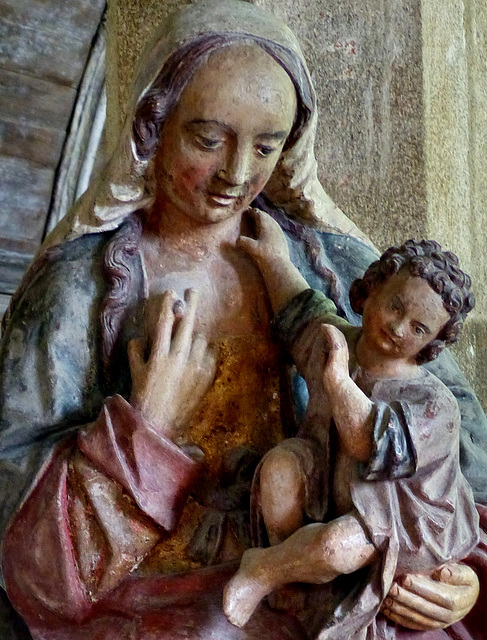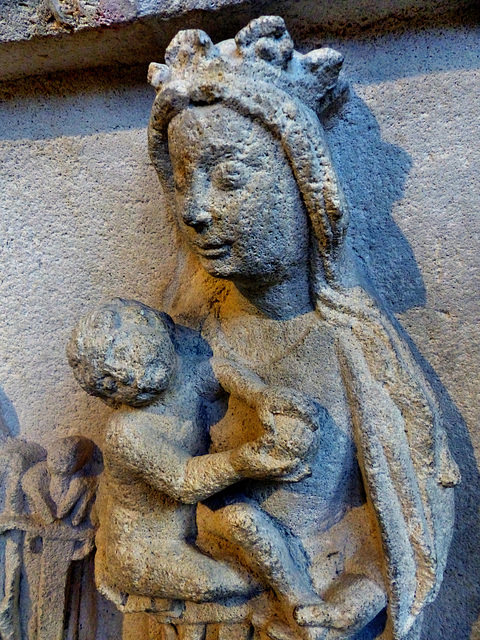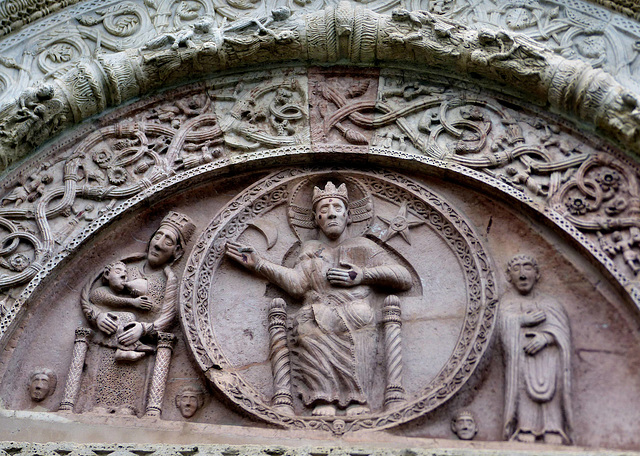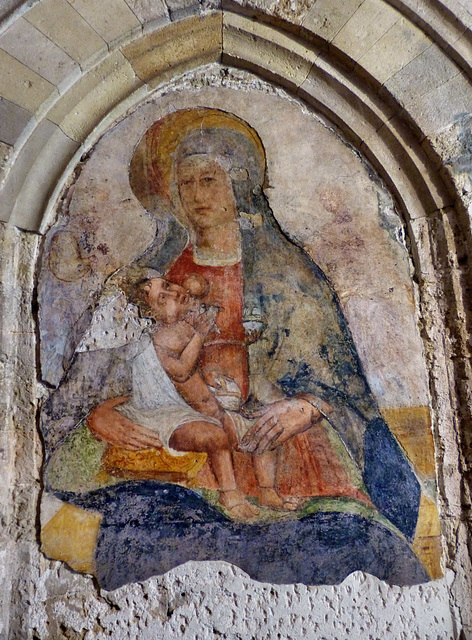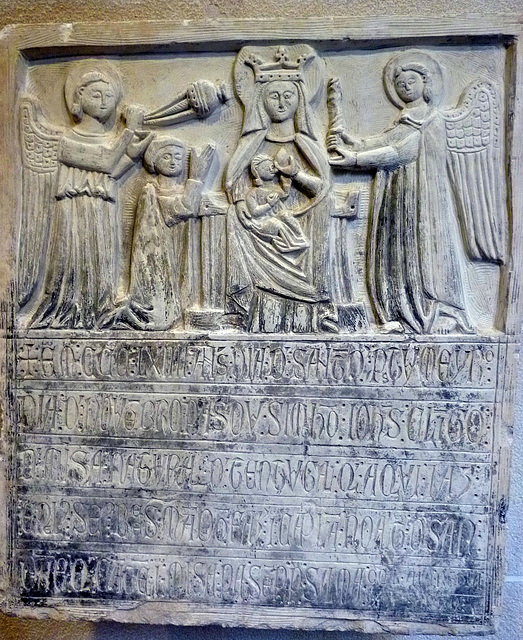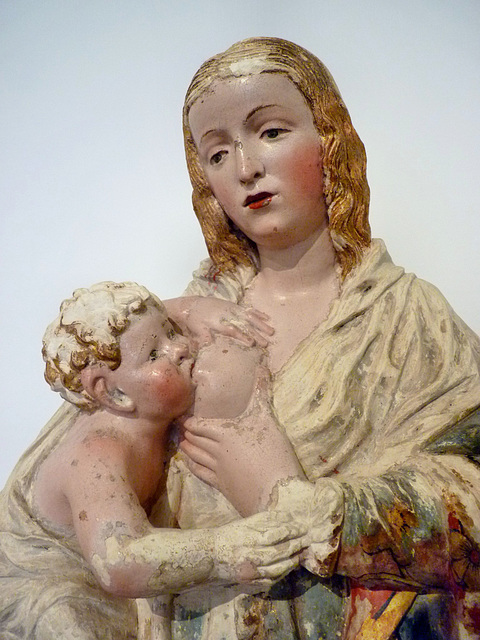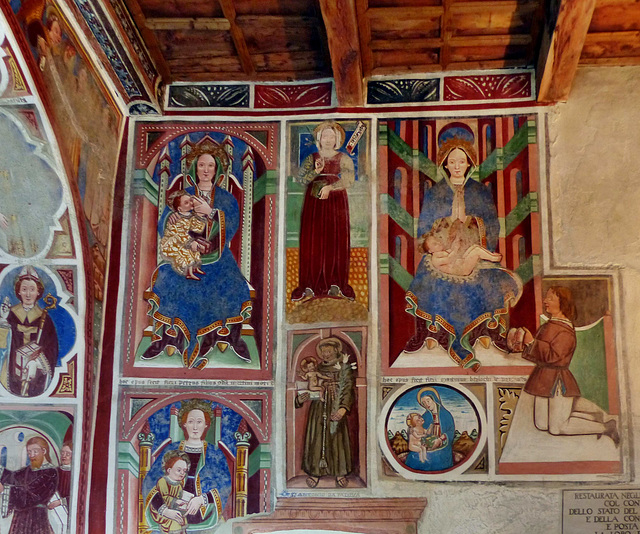
Maria lactans
The nursing Madonna is an iconography of the Madonna and Child in which Mary is depicted nursing the infant Jesus. It is a very popular image, because noble women usually had wet nurses.
Plouha - Chapelle de Kermaria-an-Iskuit
The Kermaria-an-Iskuit chapel has undergone many changes over the centuries. The construction of the oldest existing part is contributed to Henri d'Avaugour (+ 1183), count of Trégor and Goëlo, to give thanks after having returned from a crusade. In the 15th century the porch, seen here, and the transverse chapel were added.
During the 19th century the structure was in real danger, when the parish priest wanted to demolish the chapel in order to construct the "modern" village church. The population resisted this plans - and so saved the building.
Once this chapel was a place for pilgrimages, as the chapel is dedicated to the worship of "Itron Varia an Iskuit" (Saint Mary of the Healing) and following the local information, a traditional feast is still celebrated on the 3rd Sunday in September.
There are some extraordinary statues here. I found three different statues of Virgin Mary holding infant Jesus. Here Jesus seems seems not to like breastfeeding.
A "Nursing Madonna" (aka "Madonna Lactans", "Maria lactans") was a popular "icon" from the 14th century on. There is even a "Lactatio Bernardi", based on vision of Bernard of Clairvaux where the Virgin sprinkled milk on Bernard´s lips.
Burgos - Cathedral
The construction of the cathedral was ordered by King Ferdinand III of Castile and Mauricio, the Bishop of Burgos. Ferdinand had just married Barbarossa´s granddaughter Beatrice of Swabia (aka "Elisabeth of Swabia") and wanted a cathedral, reflecting his new role in the European power game.
The former Romanesque cathedral got demolished and on July 20, 1221, the construction of the new Gothic started under the guidance of an unknown French architect. After nine years, the chevet was completed and the high altar was consecrated. Then the construction stopped for about 200 years.
Attending the Council of Basel (aka "Council of Florence") in 1435 bishop (and diplomat) Alfonso de Cartagena saw the just completed, elegant towers of the Basel Minster. When he returned to Burgos he was accompanied by German architect Johannes von Köln (aka "Juan de Colonia"), who probably knew the blueprints of the towers, planned for the Cathedral of Cologne. Under his guidance the towers of the Cathedral were completed in open tracery. He was followed on the construction site by his son Simon de Colonia. Francisco de Colonia, Simon´s son, continued the work and created the Pellejería-Portal. This was a family business.
Virgin Mary holding infant Jesus. Jesus acts like a very hungry breast-fed baby.
This sculpture can be seen in the context of a "Nursing Madonna" (aka "Madonna Lactans", "Maria lactans"). These icons were popular from the 14th century on.
Santo Domingo de la Calzada - Cathedral
The town was founded by the hermit Domingo de la Calzada (aka "Dominic of the Causeway"), who supported the pilgrims on the way to Santiago de Compostela. Domingo not only built a hospital for the pilgrims, but as well a paved causeway and a bridge.
He was such a successful architect, that he is still patron saint of the Spanish civil engineers. The first church, erected by him, got consecrated in 1106. Since 1232 this was the Seat of the Bishops of the Calahorra-La Calzada and Logroño, so the structure got enlarged and modified.
Around the former cloister now is a museum, there are many sculptures.
Here is a "Nursing Madonna" (aka "Madonna Lactans", "Maria lactans"). This was a popular "icon" from the 14th century on. Little Jesus seems not really enthusiastic about mother´s milk.
Assisi - Cattedrale di San Rufino
Assisi is located on a steep slope (accessible via escalators) and a site of many a pilgrimage. Even in winter it can be very crowded - and a day before, we had to turn back, as all parking lots in the valley below were full. A day later, in heavy rain, we tried it again - and were in luck.
This "Cattedrale di San Rufino" of today is the third church on this spot. They had been built over the tomb of Saint Rufinus, Bishop of Assisi, martyred in the 3rd century.
The construction of the cathedral was started in 1134. When in 1228 Pope Gregory IX was in Assisi for the canonization of Saint Francis, he consecrated the high altar of the cathedral, that was finally completed in 1253.
Of course during the long time of construction, the church was in use already. Saint Francis was baptized here in 1182, Saint Clare in 1193.
The Romanesque façade of the Assisi-Cathedral is one of the richest in Umbria. A more detailed view on to the tympanum´s center.
A "Majestas Domini". The "Pantokrator" is crowned and flanked by sun and moon. I do not know, who is the person to the right (Joseph?). To the left is a crowned (!) Virgin - "lactans". I cannot remember having ever seen a "Nursing Madonna" (aka "Madonna Lactans", "Maria lactans") on a tympanum before. These icons were popular from the 14th century on.
I do not know, why the icon is tilt. The inner archivolt has some nice "real life" scenes.
Ivrea - Duomo di Santa Maria
The first Christian church was built here at the site of a Roman temple in the 4th century. A tree nave basilica existed in the 9th century. A Romanesque cathedral was built, when Bishop Warmund (= Warmondo) had his episcopal see here, end of the 10th century. It is known, that this church had a "westwerk", following the Ottonian architecture, popular at that time north of the Alpes.
Alterations and rebuildings were undertaken in the 13th, 15th and 16th century. In 1785 it was rebuilt again in a Baroque style, but parts of the ambulatory and the large crypt below the choir were not demolished and are still originating from the Romanesque church. Once probably all the interior walls of the crypt were covered with frescoes, though this one is clearly younger than that, seen on the previous upload.
Palermo - La Magione
Sicily, the largest Mediterranean island, has a long history, that starts around 8000 BC, but later there were Phoenician, Carthaginian, Greek and Roman periods. After the Roman Empire had fallen apart the Vandals tried to take over the island but failed. Finally, the Ostrogoths took possession.
Mid of the 6th century Sicily was conquered by troops of the Byzantine Empire. After the advent of Islam, Sicily got attacked by the Arab forces. Raids seeking loot continued until the mid-8th century.
A Muslim army was sent to the island in 827 but met with much resistance. So it took a century to conquer it and even later revolts constantly occurred
In 1038 the Byzantines invaded the island supported by Norman mercenaries, led by Roger. In 1072, after the siege of Palermo, most of Sicily was under Norman control. Roger´s son Roger II raised the status +of the island to a kingdom in 1130. During this period, the Kingdom of Sicily was prosperous and powerful,
The court of Roger II became melting out of culture from Europe and the Middle East. This attracted scholars, scientists, artists, and artisans. Muslims, Jews, Greeks, Lombards, and Normans cooperated and created some extraordinary buildings.
In 1186 the last descendant of Roger, Constance of Sicily married Emperor Henry VI, the second son of Barbarossa. So the crown of Sicily was passed on to the Hohenstaufen Dynasty. Frederick II, the only son of Constance, was crowned King of Sicily at the age of four in 1198. He became "Stupor Mundi", one of the greatest and most cultured men of the Middle Ages.
Palermo, founded in 734 BC by the Phoenicians, became a possession of Carthage and later was part of the Roman Empire. From 831 to 1072 the city was under Arab rule. Following the Norman conquest, Palermo became the capital of a new Kingdom of Sicily and the capital of the Holy Roman Empire under Emperor Frederick II and King Conrad IV.
"Santissima Trinità della Magione" (= "La Magione") was one of the last churches built under Normannic rule.
Foundation took place 1140/50 by Matthew of Ajello, William II of Sicily´s chancellor. It was completed in 1192 by Matthew´s son Archbishop Nikolaus of Salerno. Built on the place of an older mosque it was entrusted the Cistercians und was used as a burial place. Tancred of Sicily and his son Roger III of Sicily were buried in this church.
In 1197, after Emperor Henry VI, husband of Constance daughter and heiress of King Roger II of Sicily, had taken over the kingdom the church and the adjoined monastery were given to the Teutonic Knights.
The church got altered a couple of times, but the restoration of the late 12th and early 20th century "cleaned" the structure from baroque and classisistic addons. Severely damaged during WWII the church another restoration was realized.
Adjoining the church is the cloister and the Cappella di San Luca, where this "Madonna della Gracie", can be found, a fresco of the 15th century.
The "Nursing Madonna" (= "Maria lactans") was a popular icon from the 14th century on.
Coimbra - Machado de Castro National Museum
A Roman settlement, named "Aeminium" existed here. When the neighbouring town "Conimbriga" got conquered and destroyed by the Suebes in 468, the survivors moved to "Aeminium" - and renamed it. The Visigoths under King Wittiza named the town "Eminio" later. In 714 the town was conquered by Muslim troops, who changed the name again.
Coimbra was finally recaptured in 1064 by King Fernando de Castilla y León. Coimbra became the second capital of the Kingdom of Portugal (after Guimarãesin) 1139, a status that moved to Lisbon in 1256. The University of Coimbra, founded by Denis of Portugal (aka "Dom Dinis") in 1290, is one of the oldest in Europe.
Coimbra hosts the "Machado de Castro National Museum", named after Machado de Castro, a Portuguese sculptor of the late 18th century. It has a wide, very interesting collection. Here are some examples.
A Gothic funerary inscription, dating from the 13th/14th century. The Virgin is breastfeeding little Jesus, while the two flanking angels swing the censer and hold a candle. The person on his/her knees is probably stands for the soul of the deceased patron.
www.museumachadocastro.gov.pt/en-GB/2%20museu/ContentList...
Coimbra - Machado de Castro National Museum
A Roman settlement, named "Aeminium" existed here. When the neighbouring town "Conimbriga" got conquered and destroyed by the Suebes in 468, the survivors moved to "Aeminium" - and renamed it. The Visigoths under King Wittiza named the town "Eminio" later. In 714 the town was conquered by Muslim troops, who changed the name again.
Coimbra was finally recaptured in 1064 by King Fernando de Castilla y León. Coimbra became the second capital of the Kingdom of Portugal (after Guimarãesin) 1139, a status that moved to Lisbon in 1256. The University of Coimbra, founded by Denis of Portugal (aka "Dom Dinis") in 1290, is one of the oldest in Europe.
Coimbra hosts the "Machado de Castro National Museum", named after Machado de Castro, a Portuguese sculptor of the late 18th century. It has a wide, very interesting collection. Here are some examples.
A "Virgem do Leite" (aka "Virgo lactans") attributed to the "Mestre dos Túmulos Reais", a sculptor otherwise known from his works around the tomb of Afonso I de Portugal.
The breastfeeding Virgin was a theme, that was made popular by the Cistercians. The "Lactatio Bernardi" is based on a miracle or vision concerning Cistercian Bernard of Clairvaux where the Virgin sprinkled milk on his lips.
www.museumachadocastro.gov.pt/en-GB/2%20museu/ContentList...
Acquarossa - San Carlo di Negrentino
The church "San Carlo di Negrentino", originally dedicated to S. Ambrogio Vecchio, is located isolated facing a cliff that opens onto a vast panorama. A mule track led here from the Gotthard Pass over the Narapass to the Blenio Valley and to Bellinzona led past here near a deep gorge.
The two-aisled church is first mentioned in writing in 1214 but goes back to an earlier time. It was created in two construction phases. The original Romanesque apse hall from the 11th century was probably extended in the 13th century in the south by a similar, but narrower room with a smaller apse. At that time the campanile was built on the north side of the building.
Both aisles of the church are adorned with frescoes. As between the aisles are about 200 years, the styles differ clearly.
Seen on the left is a "Nursing Madonna" (= "Madonna Lactans"). Such icons got popular around the 14th century.
Jump to top
RSS feed- Latest items - Subscribe to the latest items added to this album
- ipernity © 2007-2024
- Help & Contact
|
Club news
|
About ipernity
|
History |
ipernity Club & Prices |
Guide of good conduct
Donate | Group guidelines | Privacy policy | Terms of use | Statutes | In memoria -
Facebook
Twitter

